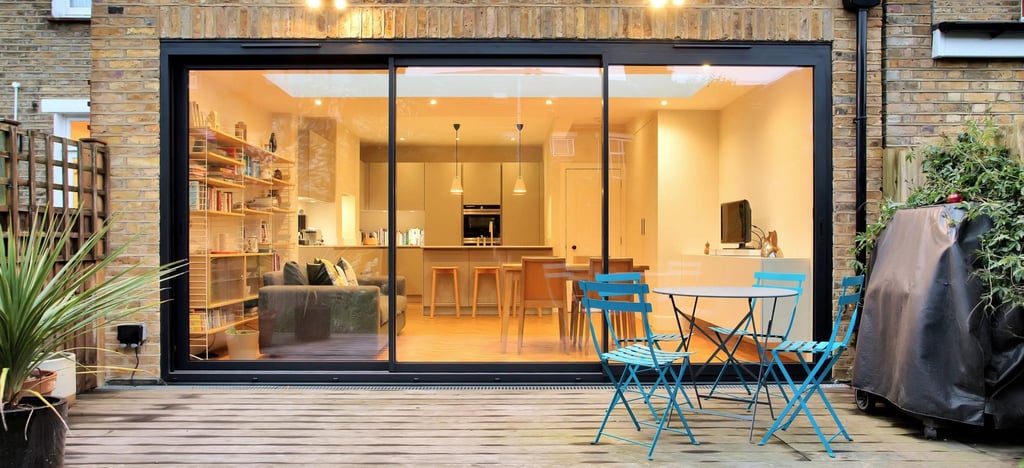Single Storey Extension UK: Design Trends, Costs & Planning Rules 2025
5/11/20254 min read


Single Storey Extensions UK: Design Ideas, Costs, and Planning Guide for 2025
In the ever-evolving UK property market, homeowners are increasingly turning to single storey extensions to create more usable living space without moving house. Whether you're dreaming of an open-plan kitchen, a light-filled lounge, or a modern utility room, a ground floor extension is often the smartest and most cost-effective solution.
In this 2025 guide, we’ll explore everything you need to know — from planning permission and building regulations to trending design ideas, costs, and construction considerations.
What Is a Single Storey Extension?
A single storey extension is a structure added to one level of a house—usually to the rear, side, or in a wraparound format—to expand ground-floor living areas. These are typically used to extend kitchens, dining rooms, or family areas or to add bathrooms and utility rooms.
They are incredibly versatile and popular for:
Growing families
Working-from-home setups
Increasing property value
Modernising older layouts
Do You Need Planning Permission for a Single Storey Extension in the UK?
Many single storey extensions in the UK fall under Permitted Development (PD) rights, which means you don’t always need full planning permission, provided certain conditions are met.
The main rules under PD (as of 2025) are
The extension must not project more than 3 metres from the rear wall of the original house for attached homes (4 metres for detached).
The maximum height at the eaves must not exceed 3 metres.
The overall height must not exceed 4 metres.
Materials must be similar in appearance to the existing house.
No more than 50% of your garden should be covered by the extension.
It must not be forward of the principal elevation (i.e., not in front of the house).
Note: If your home is in a conservation area, a listed building, or has had PD rights removed, you will need to apply for planning permission.
For larger extensions (up to 6m for semis or 8m for detached houses), you’ll need to go through the Neighbour Consultation Scheme.
Building Regulations for Single Storey Extensions
Even if you don’t need planning permission, Building Regulations approval is always required. This ensures the extension meets UK standards for:
Structural integrity (foundations, walls, roofs)
Insulation and energy efficiency
Fire safety and escape routes
Drainage and damp-proofing
Electrical and plumbing works
You’ll typically need to submit plans and have inspections at key stages (e.g., after foundations and before plastering). Most homeowners work with an architect and a contractor who handles the paperwork and liaises with Building Control.
How Much Does a Single Storey Extension Cost in the UK (2025)?
Costs vary depending on size, design, location, and finish, but here’s a realistic breakdown:
In 2025, the average cost of a single storey extension in the UK ranges from £1,800 to £2,500 per square metre.
A small 3x3 metre kitchen extension could cost between £18,000 and £25,000, depending on spec.
A larger open-plan 6x5 metre space with bifold doors and skylights might cost £45,000 to £70,000 or more.
In London and the South-east, expect to pay a 10–25% premium due to higher labour and material costs.
Always budget for professional fees (around 10–15% of total cost), VAT, and potential unforeseen costs (e.g., drainage relocation or underpinning).
Trending Single Storey Extension Ideas for 2025
Open-Plan Kitchen-Living-Dining Space
One of the most sought-after layouts combines a modern kitchen with a dining area and snug lounge, opening into the garden with bifold or sliding glass doors.
Garden Room with Full-Width Glazing
A light-filled room with a vaulted ceiling and panoramic garden views—perfect for entertaining, working, or relaxing.
Utility and Boot Rooms
Tidy up your home with a dedicated laundry area and boot room, especially useful for families and pet owners.
Ground Floor Bathroom or Wet Room
Ideal for accessibility, guests, or multigenerational households, adding a full bathroom downstairs is a smart move.
Glazed Side Return Extension
Transform a narrow side alley into usable indoor space with a contemporary side return extension, a favourite in London terraces.
Pros and Cons of Single Storey Extensions
✔️ Pros:
Increases floor space without the complexity of loft or two-storey builds
More affordable and faster than full renovations
Often possible under permitted development
Great for modernising old layouts
Adds strong resale value when well-executed
❌ Cons:
May reduce garden size
Can be disruptive during construction
Costs can spiral if ground conditions are poor or you change plans mid-project
What to Do Before You Begin
Before starting your extension, make sure you:
Check your PD rights or apply for planning if needed
Hire a qualified architect or designer
Get a structural engineer for foundation and load-bearing checks
Submit for Building Regulations approval
Get multiple quotes from experienced builders
Speak to your neighbours if near boundary lines (Party Wall Act may apply)
Does a Single Storey Extension Add Value?
Absolutely. A well-designed and approved extension can add 10% to 20% to your property’s market value—more in high-demand areas like London and the South East.
Estate agents consistently rate ground-floor extensions as one of the most desirable home improvements for UK buyers.
Final Thoughts
A single storey extension remains one of the most practical and rewarding ways to transform your home in 2025. Whether you want to expand your kitchen, create an open-plan living space, or simply make your ground floor more functional, the possibilities are nearly endless. With thoughtful planning, expert guidance, and an eye for design, you can unlock new potential in your property without the need to relocate.
While costs and permissions are important factors, the long-term benefits—from lifestyle improvements to added property value—make single storey extensions a wise investment. Just be sure to consult with experienced professionals, stay compliant with UK planning laws and building regulations, and approach the project with a clear vision.